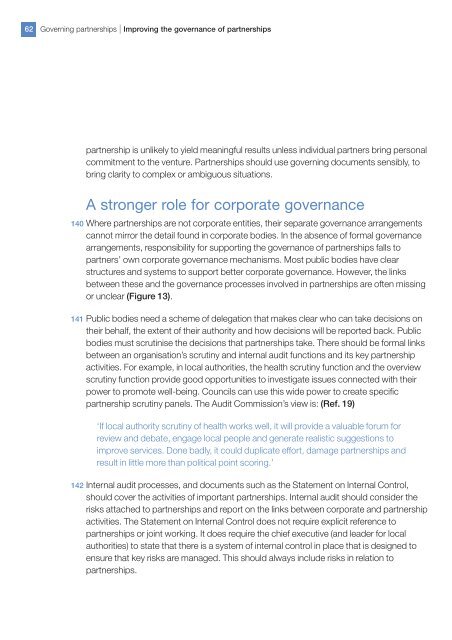Bridging the accountability gap - Audit Commission
Bridging the accountability gap - Audit Commission
Bridging the accountability gap - Audit Commission
You also want an ePaper? Increase the reach of your titles
YUMPU automatically turns print PDFs into web optimized ePapers that Google loves.
62<br />
Governing partnerships | Improving <strong>the</strong> governance of partnerships<br />
partnership is unlikely to yield meaningful results unless individual partners bring personal<br />
commitment to <strong>the</strong> venture. Partnerships should use governing documents sensibly, to<br />
bring clarity to complex or ambiguous situations.<br />
A stronger role for corporate governance<br />
140 Where partnerships are not corporate entities, <strong>the</strong>ir separate governance arrangements<br />
cannot mirror <strong>the</strong> detail found in corporate bodies. In <strong>the</strong> absence of formal governance<br />
arrangements, responsibility for supporting <strong>the</strong> governance of partnerships falls to<br />
partners’ own corporate governance mechanisms. Most public bodies have clear<br />
structures and systems to support better corporate governance. However, <strong>the</strong> links<br />
between <strong>the</strong>se and <strong>the</strong> governance processes involved in partnerships are often missing<br />
or unclear (Figure 13).<br />
141 Public bodies need a scheme of delegation that makes clear who can take decisions on<br />
<strong>the</strong>ir behalf, <strong>the</strong> extent of <strong>the</strong>ir authority and how decisions will be reported back. Public<br />
bodies must scrutinise <strong>the</strong> decisions that partnerships take. There should be formal links<br />
between an organisation’s scrutiny and internal audit functions and its key partnership<br />
activities. For example, in local authorities, <strong>the</strong> health scrutiny function and <strong>the</strong> overview<br />
scrutiny function provide good opportunities to investigate issues connected with <strong>the</strong>ir<br />
power to promote well-being. Councils can use this wide power to create specific<br />
partnership scrutiny panels. The <strong>Audit</strong> <strong>Commission</strong>’s view is: (Ref. 19)<br />
‘If local authority scrutiny of health works well, it will provide a valuable forum for<br />
review and debate, engage local people and generate realistic suggestions to<br />
improve services. Done badly, it could duplicate effort, damage partnerships and<br />
result in little more than political point scoring.’<br />
142 Internal audit processes, and documents such as <strong>the</strong> Statement on Internal Control,<br />
should cover <strong>the</strong> activities of important partnerships. Internal audit should consider <strong>the</strong><br />
risks attached to partnerships and report on <strong>the</strong> links between corporate and partnership<br />
activities. The Statement on Internal Control does not require explicit reference to<br />
partnerships or joint working. It does require <strong>the</strong> chief executive (and leader for local<br />
authorities) to state that <strong>the</strong>re is a system of internal control in place that is designed to<br />
ensure that key risks are managed. This should always include risks in relation to<br />
partnerships.








